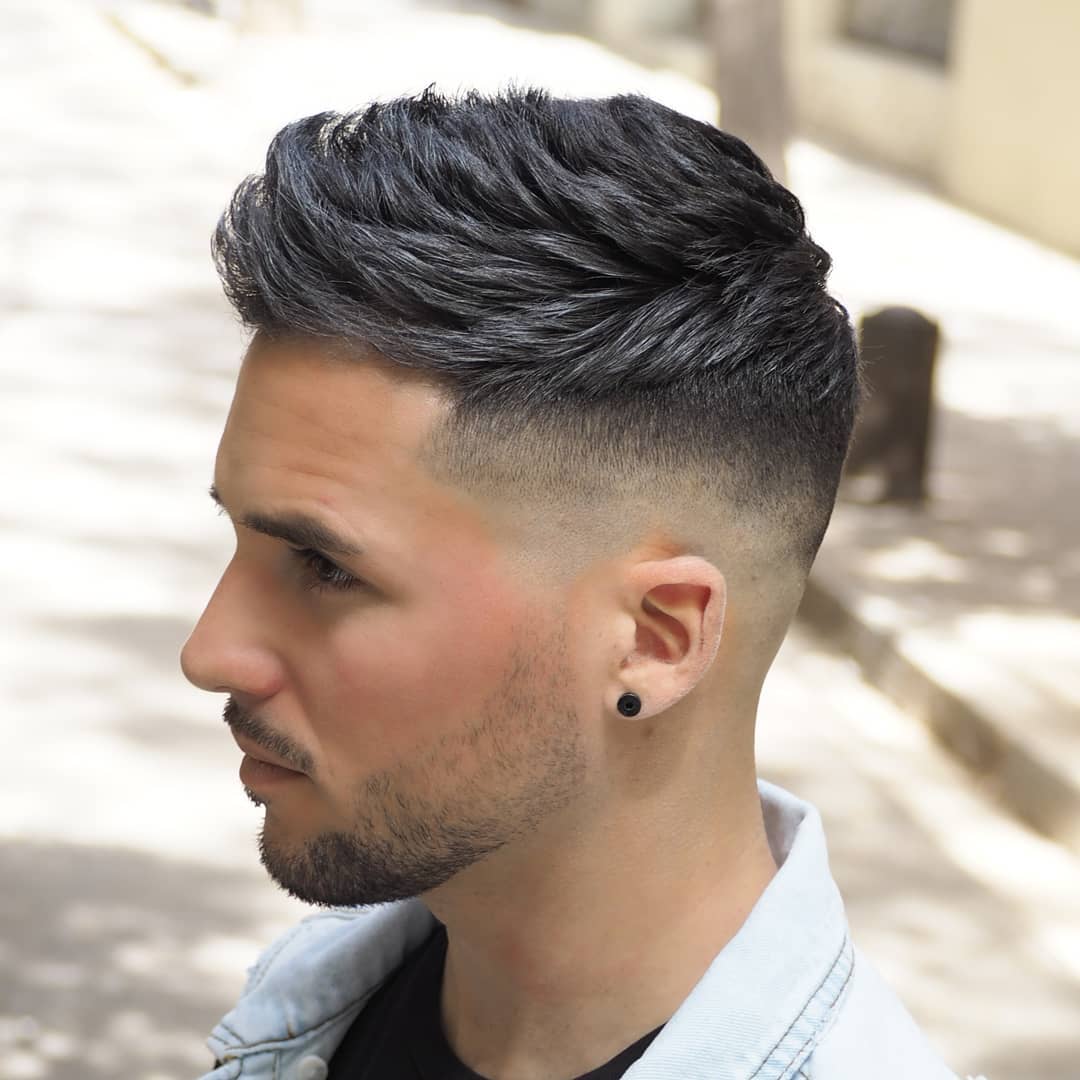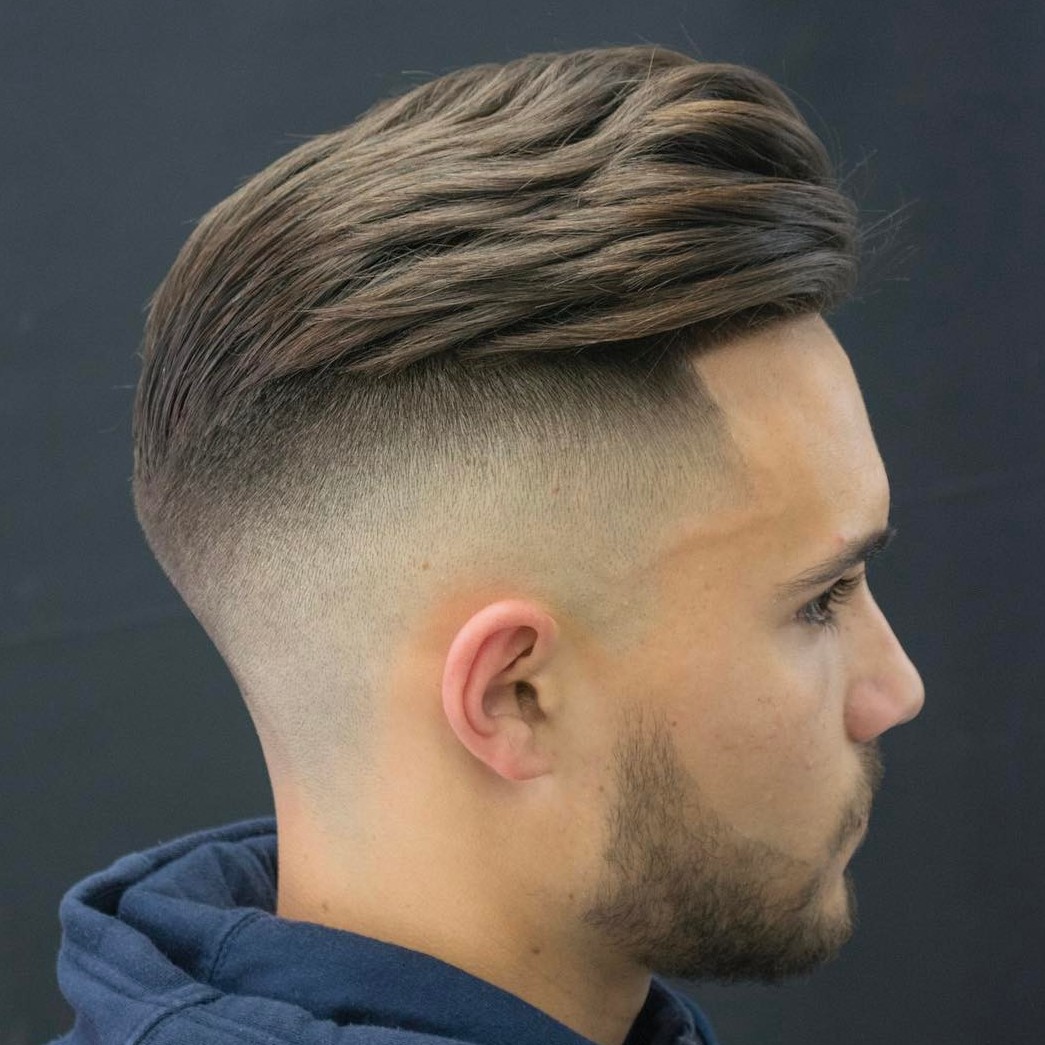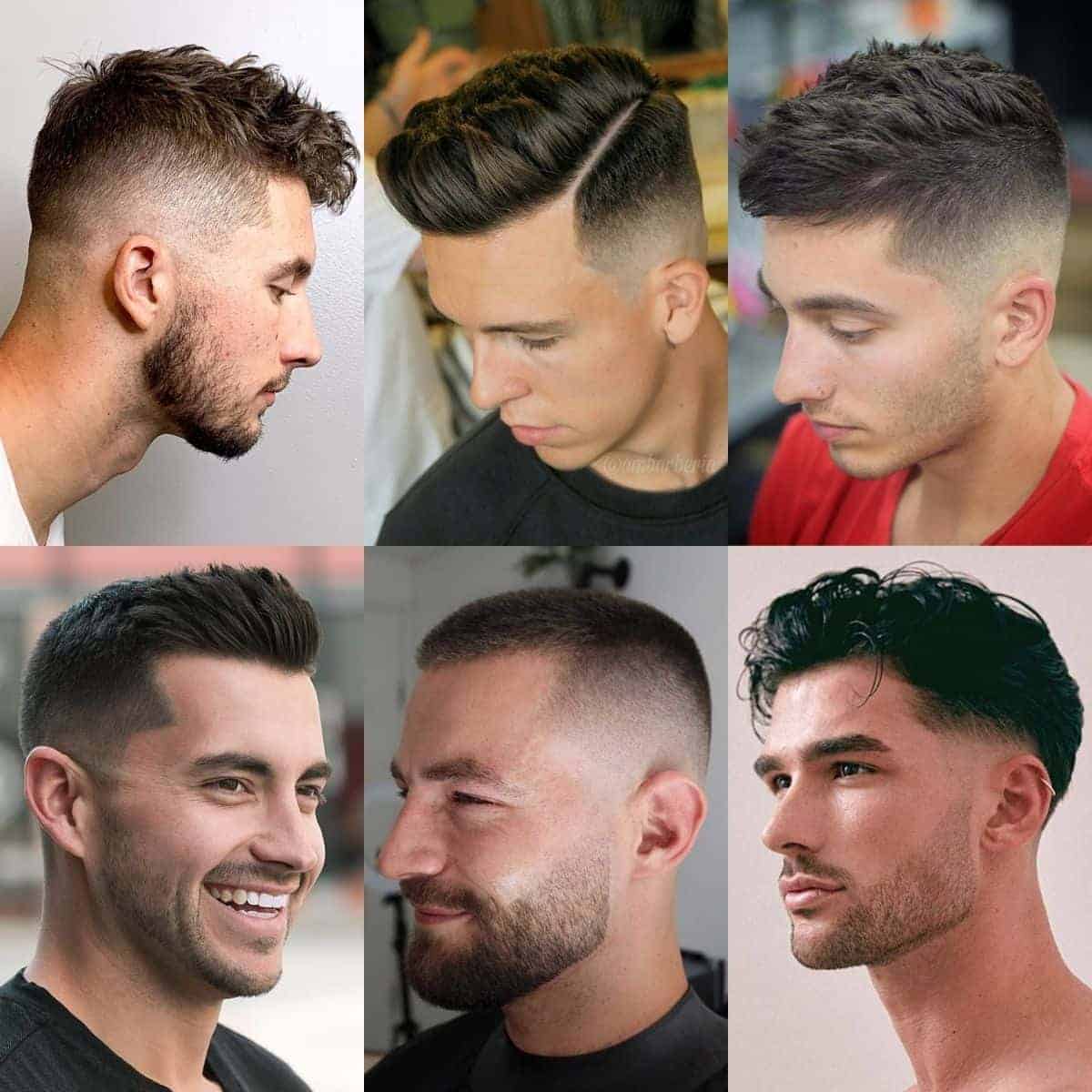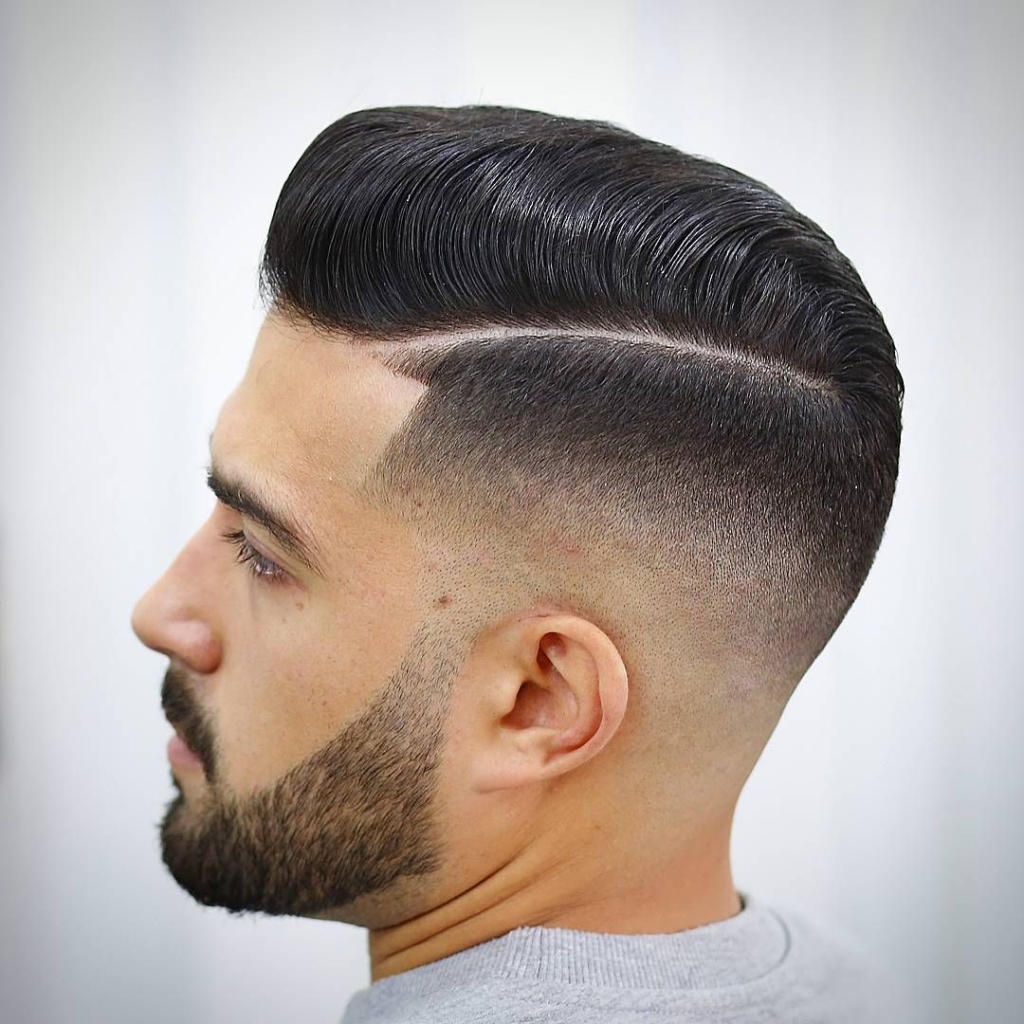What’s a fade haircut? It’s a popular and versatile hairstyle that involves gradually blending the hair from short to long, creating a smooth transition from the top of the head to the neckline. Whether you’re considering getting a fade or just curious about this trendy style, this comprehensive guide will provide you with everything you need to know.
Fade haircuts have become increasingly popular in recent years, thanks to their versatility and stylish appearance. They can be customized to suit any hair type, face shape, and personal preference, making them a great choice for men of all ages.
Fade Haircut Overview
A fade haircut is a type of haircut that gradually blends the hair from short to long, creating a seamless transition. Fade haircuts are popular among men and can be customized to suit different face shapes and hair types.
There are several different types of fades, including:
- High fade: The fade starts high on the head, just above the temples.
- Mid fade: The fade starts at the middle of the head, just above the ears.
- Low fade: The fade starts low on the head, just above the neckline.
- Skin fade: The fade blends the hair down to the skin, creating a sharp contrast.
Getting a fade haircut typically involves the following steps:
- The barber will start by washing and combing your hair.
- The barber will then use clippers to create the desired length on the sides and back of your head.
- The barber will then use a razor or clippers to blend the hair from short to long, creating the fade.
- The barber will then style your hair as desired.
Here are some tips on how to style a fade haircut:
- Use a pomade or wax to add shine and definition to your hair.
- Use a blow dryer to create volume and shape.
- Use a hairspray to hold your style in place.
Benefits of a Fade Haircut
Fade haircuts offer a range of benefits, making them a popular choice among individuals seeking a stylish and low-maintenance haircut.
One significant advantage of a fade is its ease of maintenance. The gradual blending of hair length from short to longer requires minimal upkeep, reducing the need for frequent trims or styling. This makes it an ideal option for individuals with busy lifestyles who value convenience.
Versatility for Various Hair Textures
Fades are incredibly versatile and complement a wide range of hair textures. They can enhance the natural curls of coily or wavy hair, adding definition and volume. For straight hair, fades create a sleek and polished look that accentuates the hair’s natural movement.
Accentuating Facial Features
Fade haircuts can effectively accentuate facial features, highlighting the wearer’s bone structure and facial shape. A high fade, for instance, draws attention to the forehead and eyes, while a mid fade frames the face and jawline. A low fade, on the other hand, creates a more subtle effect, blending seamlessly into the wearer’s natural hair.
Benefits Summary Table
The following table summarizes the key benefits of fade haircuts:
| Benefit | Advantages for Different Hair Types and Face Shapes |
|---|---|
| Low-maintenance | Reduces the need for frequent trims or styling |
| Versatility | Complements a wide range of hair textures, from coily to straight |
| Accentuates facial features | Highlights the forehead, eyes, jawline, and bone structure |
“Consultation and customization are crucial when creating a fade haircut,” says professional barber John Smith. “Understanding the client’s hair texture, face shape, and personal style allows us to tailor the fade to their unique features, ensuring a flattering and stylish result.”
Types of Fades
There are several types of fades, each achieving a distinct effect:
- High fade: Blends hair from the top of the head to a short length at the sides and back, creating a dramatic contrast.
- Mid fade: Starts the fade at the middle of the head, resulting in a more gradual transition from long to short hair.
- Low fade: Blends hair from the bottom of the head, creating a subtle and conservative effect.
How to Ask for a Fade Haircut

Requesting a fade haircut requires clear communication to ensure the barber understands your desired look. This guide provides tips on effectively conveying your preferences.
Communicating Fade Level
Specify the fade level you prefer, ranging from low to high. A low fade starts higher on the sides and gradually fades into longer hair, while a high fade extends higher up the head.
Describing Length and Transition
Describe the length you want the hair to be at the shortest point of the fade. Also, specify the desired transition between the faded area and the longer hair above it. A sharp transition creates a defined line, while a gradual transition results in a smoother blend.
Importance of Clear Communication
Clear communication is crucial to ensure the barber accurately interprets your request. Use specific terms and avoid vague language. If possible, bring a photo or reference image to illustrate your desired fade.
– Share tips on maintaining a fade haircut.: What’s A Fade Haircut

Maintaining a fade haircut requires regular upkeep to keep it looking fresh and sharp. Here are some tips:
- Wash and condition your hair regularly. This will help to keep your hair healthy and free of dirt and oil, which can weigh it down and make it look greasy.
- Use a good quality shampoo and conditioner. Look for products that are designed for your hair type and that will help to keep your hair healthy and looking its best.
- Get regular trims. This will help to keep your hair looking neat and tidy, and will also help to prevent split ends.
- Use a styling product. A styling product can help to hold your hair in place and give it a more polished look.
- Avoid using too much heat on your hair. Heat can damage your hair and make it look frizzy and dry.
Fade Haircut Variations
Fade haircuts offer a wide range of variations, each with its unique characteristics. From high to mid to low fades, the transition from longer hair on top to shorter hair on the sides and back can vary significantly.
High Fade
- Starts high on the sides and back, blending into the longer hair on top.
- Creates a sharp and edgy look.
- Examples: Chris Brown, Justin Bieber
Mid Fade, What’s a fade haircut
- Starts around the middle of the sides and back, gradually blending into the longer hair on top.
- Offers a more balanced and versatile look than a high fade.
- Examples: David Beckham, Brad Pitt
Low Fade
- Starts low on the sides and back, creating a subtle and understated transition.
- Suitable for those who prefer a more conservative look.
- Examples: George Clooney, Will Smith
Fade Haircut with Designs
Designs can elevate a fade haircut, adding a unique and personalized touch. They complement the gradual transition of the fade, creating a visually striking effect.
Popular design options include:
Line Designs
- Sharp lines create a clean and edgy look.
- They can be incorporated into the fade itself or added as accents.
Geometric Designs
- Triangles, squares, and other geometric shapes add a modern and structured element.
- They can be shaved into the fade or Artikeld with a trimmer.
Tribal Designs
- Inspired by ancient tribal art, these intricate patterns add a touch of cultural flair.
- They can be shaved into the fade or created with a stencil.
Incorporating designs into a fade requires precision and attention to detail. A skilled barber will discuss your design preferences and work with you to create a custom look that complements your hair texture and facial features.
Fade Haircuts and Beards: A Perfect Pair
A fade haircut can complement a beard in a number of ways, creating a cohesive and stylish look. Here are a few reasons why you might consider getting a fade haircut if you have a beard:
Enhances facial features: A fade haircut can help to define your facial features, making them appear more prominent. The gradual transition from short to long hair can draw attention to your cheekbones, jawline, and eyes.
Creates a cohesive look: A fade haircut can help to create a more cohesive look between your hair and beard. By gradually blending the two, you can avoid the harsh line that can sometimes occur between different hair lengths.
Adds style and personality: A fade haircut can add a touch of style and personality to your overall look. There are many different types of fades to choose from, so you can find one that suits your individual taste.
Choosing the Right Fade Type for Your Beard Style
When choosing a fade type for your beard style, there are a few things to consider, including:
- Beard length: The length of your beard will affect the type of fade that you choose. If you have a short beard, you may want to consider a high fade, which will start higher up on your head. If you have a longer beard, you may want to consider a low fade, which will start lower down on your head.
- Beard shape: The shape of your beard will also affect the type of fade that you choose. If you have a round beard, you may want to consider a fade that will help to elongate your face. If you have a square beard, you may want to consider a fade that will help to soften your jawline.
- Desired effect: Ultimately, the type of fade that you choose will depend on the desired effect that you are trying to achieve. If you want a subtle look, you may want to consider a low fade. If you want a more dramatic look, you may want to consider a high fade.
Blending the Fade into the Beard
Once you have chosen a fade type, it is important to blend it into your beard seamlessly. Here are a few tips:
- Use clippers with a fine-tooth blade: This will help to create a smooth transition between the two hair lengths.
- Start by fading the hair at the temples: This will help to create a natural-looking transition.
- Gradually work your way down the sides of the head: Be sure to blend the fade into the beard as you go.
- Use a beard trimmer to clean up the edges: This will help to create a sharp, clean line between the fade and the beard.
Examples of Fade Haircuts that Pair Well with Different Beard Styles
Here are a few examples of fade haircuts that pair well with different beard styles:
- High fade with a short beard: This is a classic combination that is both stylish and easy to maintain.
- Low fade with a long beard: This is a more dramatic look that is perfect for men with a lot of facial hair.
- Mid fade with a medium beard: This is a versatile look that can be adapted to suit any beard style.
Table Summarizing Key Points
The following table summarizes the key points of this discussion:
| Fade Type | Beard Style | Blending Technique |
|---|---|---|
| High fade | Short beard | Start by fading the hair at the temples and gradually work your way down the sides of the head. |
| Low fade | Long beard | Start by fading the hair at the temples and gradually work your way down the sides of the head. |
| Mid fade | Medium beard | Start by fading the hair at the temples and gradually work your way down the sides of the head. |
Fade Haircut for Special Occasions
Fades can be styled for formal events with the use of hair products and styling techniques.
Examples of Fade Haircuts for Special Occasions
For weddings, proms, and other special occasions, consider the following fade haircuts:
– High Fade with Pompadour: A high fade with a pompadour on top adds volume and height, creating a sophisticated look.
– Mid Fade with Slick Back: A mid fade with a slicked-back top is a classic and elegant style.
– Low Fade with Side Part: A low fade with a side part and a bit of product adds a touch of polish and style.
Fade Haircut Trends

Fade haircuts have evolved significantly over time, with new variations and techniques emerging to meet the ever-changing demands of style-conscious individuals. Here’s an overview of the latest fade haircut trends:
High Fade
A high fade starts high on the sides and back of the head, gradually blending into longer hair on top. This style creates a sharp, defined contrast and is suitable for all hair types.
Mid Fade, What’s a fade haircut
A mid fade begins around the middle of the sides and back, blending into longer hair on top. It offers a more subtle transition than a high fade and is ideal for those who prefer a less dramatic look.
Low Fade
A low fade starts low on the sides and back, creating a gradual blend that almost resembles a shadow. This style is perfect for those who want a natural-looking fade that doesn’t draw too much attention.
Burst Fade
A burst fade features a high fade on the sides and back, with a short burst of hair left longer at the crown. This style adds a touch of individuality and flair to the classic fade.
Temp Fade
A temp fade, also known as a temple fade, involves fading the hair on the sides and back, leaving a strip of longer hair along the temples. This style is ideal for those who want to highlight their facial features.
Celebrities and Social Media Influence
Celebrities and social media platforms have played a significant role in shaping fade haircut trends. Many celebrities have embraced fade haircuts, showcasing variations such as high, mid, and low fades. Social media platforms like Instagram and TikTok have allowed barbers and stylists to share their work, inspiring new trends and styles.
| Fade Type | Characteristics | Best Hair Types |
|---|---|---|
| High Fade | Sharp contrast, starts high on the sides and back | All hair types |
| Mid Fade | Subtle transition, starts around the middle of the sides and back | All hair types |
| Low Fade | Gradual blend, starts low on the sides and back | Thick, coarse hair |
| Burst Fade | High fade with a short burst of longer hair at the crown | All hair types |
| Temp Fade | Faded sides and back with a strip of longer hair along the temples | All hair types |
Fade Haircut Pricing
The cost of a fade haircut can vary depending on several factors, including the location of the barbershop, the experience of the barber, and the complexity of the haircut.
Location
The cost of a fade haircut can vary depending on the location of the barbershop. In general, barbershops in large cities tend to charge more than barbershops in small towns. This is because the cost of living is higher in large cities, and barbershops need to charge more to cover their expenses.
Barber Experience
The experience of the barber can also affect the cost of a fade haircut. Barbers with more experience typically charge more than barbers with less experience. This is because experienced barbers are more likely to be able to give you a high-quality haircut.
Haircut Complexity
The complexity of the haircut can also affect the cost. A simple fade haircut, such as a low fade or a mid fade, will typically cost less than a more complex fade haircut, such as a high fade or a burst fade. This is because more complex haircuts require more time and skill to execute.
Average Cost
The average cost of a fade haircut in the United States is between $15 and $30. However, the cost can vary depending on the factors discussed above.
Fade Haircut Inspiration

Discover a wide range of fade haircut images to inspire your next style. From classic tapers to modern designs, there’s a fade to suit every preference.
Explore the gallery below to find the perfect fade haircut for you.
Classic Fade
- A gradual transition from short hair at the sides and back to longer hair on top.
- Creates a clean and polished look.
- Suitable for all hair types and textures.
High Fade
- A fade that starts high on the sides and back, leaving only a small amount of hair on top.
- Creates a bold and edgy look.
- Best suited for short to medium-length hair.
Mid Fade, What’s a fade haircut
- A fade that starts halfway up the sides and back, leaving a moderate amount of hair on top.
- Creates a versatile look that can be dressed up or down.
- Suitable for most hair types and textures.
Low Fade
- A fade that starts low on the sides and back, leaving a significant amount of hair on top.
- Creates a subtle and understated look.
- Best suited for long hair.
Burst Fade
- A fade that creates a circular or oval shape around the crown of the head.
- Creates a unique and eye-catching look.
- Best suited for short to medium-length hair.
Skin Fade
- A fade that blends the hair on the sides and back into the skin.
- Creates a sharp and clean look.
- Requires regular maintenance.
Drop Fade
- A fade that follows the natural curve of the head, creating a drop-shaped effect.
- Creates a stylish and modern look.
- Best suited for short to medium-length hair.
Design a step-by-step tutorial on how to cut a fade haircut, including detailed s with clear visuals.

### Tools and Techniques
– Clippers: Electric clippers with various clipper sizes (guards) for gradual cutting.
– Guards: Attachments for clippers that determine the length of hair to be cut.
– Combs: For blending and smoothing transitions between faded sections.
– Scissors: For trimming and shaping.
### Step-by-Step Tutorial
1. Section the Hair:
– Dampen hair and divide it into three sections: top, sides, and back.
– Secure the top section with a clip.
2. Fade the Sides and Back:
– Start with a higher guard (e.g., #4) at the top of the sides or back.
– Hold the clippers parallel to the head and move them down in a smooth motion.
– Gradually decrease the guard size (#3, #2, #1) as you move down to create a gradual fade.
3. Blend the Fade:
– Use a comb to blend the transitions between the faded sections.
– Hold the comb flat against the head and move the clippers over it to create a smooth gradient.
4. Trim the Top:
– Release the top section and comb it forward.
– Use scissors to trim and shape the top to your desired length and style.
5. Fade the Top (Optional):
– If desired, use a higher guard (#4 or #5) to fade the top section into the sides and back.
6. Check and Adjust:
– Check the fade for evenness and make adjustments as needed.
– Use a mirror to view the fade from different angles.
Conclusion
In conclusion, a fade haircut is a stylish and versatile hairstyle that can be tailored to suit any individual. With proper care and maintenance, a fade can keep you looking sharp and stylish for weeks. So if you’re looking for a fresh new look, consider getting a fade haircut.
Question Bank
What is a fade haircut?
A fade haircut is a style in which the hair is gradually blended from short to long, creating a smooth transition from the top of the head to the neckline.
What are the different types of fades?
There are several types of fades, including high fades, mid fades, low fades, and taper fades.
How do I get a fade haircut?
To get a fade haircut, you’ll need to visit a barber or stylist. They will use clippers and scissors to create the desired length and transition.
How do I style a fade haircut?
Fade haircuts can be styled in a variety of ways, depending on your personal preference. You can use products like pomade or gel to create a sleek look, or you can leave it natural for a more casual style.
